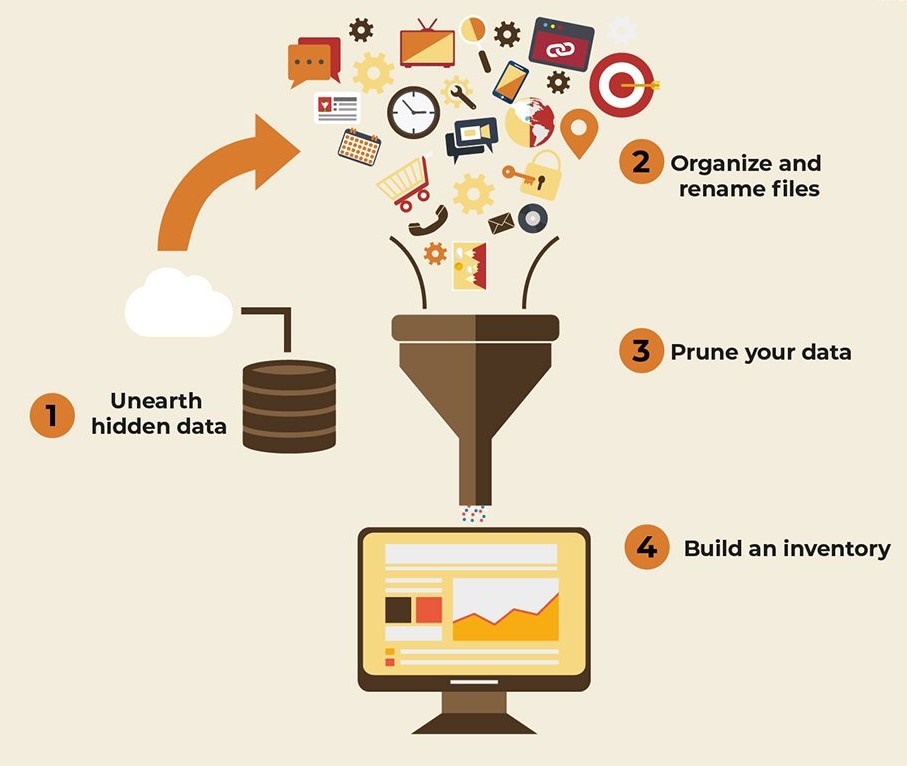
Your PIM system will function efficiently only when the quality of input data is good. This blog post talks about identifying your data assets for data cleaning and preparing it for PIM implementation.
Garbage In, Garbage Out (GIGO) is a common problem with PIM implementations. In order to have clean, usable data, you need to get the house in order *before* you begin.
.tb_button {padding:1px;cursor:pointer;border-right: 1px solid #8b8b8b;border-left: 1px solid #FFF;border-bottom: 1px solid #fff;}.tb_button.hover {borer:2px outset #def; background-color: #f8f8f8 !important;}.ws_toolbar {z-index:100000} .ws_toolbar .ws_tb_btn {cursor:pointer;border:1px solid #555;padding:3px} .tb_highlight{background-color:yellow} .tb_hide {visibility:hidden} .ws_toolbar img {padding:2px;margin:0px}

In the first post in the series on PIM, we discussed how businesses benefit from having a PIM. Then, we talked about identifying and bringing together stakeholders. In continuation, today, in part three of the series, we will explore the next task at hand — cleaning your product data in preparation for a PIM migration.
The best-laid PIM can go awry with poor input data. Several organizations have implemented a hurried PIM solution only to discover that it did not fix their data problems — it only perpetuated them. If you want to set up your PIM for long-term success, the first thing you need to do is spring-clean your data and bringing it to PIM-ready shape. Here’s how!
.tb_button {padding:1px;cursor:pointer;border-right: 1px solid #8b8b8b;border-left: 1px solid #FFF;border-bottom: 1px solid #fff;}.tb_button.hover {borer:2px outset #def; background-color: #f8f8f8 !important;}.ws_toolbar {z-index:100000} .ws_toolbar .ws_tb_btn {cursor:pointer;border:1px solid #555;padding:3px} .tb_highlight{background-color:yellow} .tb_hide {visibility:hidden} .ws_toolbar img {padding:2px;margin:0px}
How to prepare the data for a PIM implementation?
Your data-readiness efforts should start with asking two simple questions:
- What kind of data makes my product?
- Where does this data live?
What kind of data makes my product?
Let’s take the example of an ecommerce marketplace selling apparel sourced from various brands. Here’s some pertinent product data that could help the online shopper make a purchase choice:
- Brand name, product name, catalog number etc. — the identification codes of the product.
- Basic facts about the product such as style, material, and care instructions — what we call parametric product data.
- Dynamic characteristics of the product, such as the colors and sizes the design is available in — the product attributes.
- Short and long form product stories, how-to-style guides, bulleted descriptions of the apparel — marketing collateral.
- Product images, video clips and any other digital assets.
Regardless of the business you are in, your starting point is to identify all the data points that are relevant to your products and categories. Once you have consolidated this information, go looking for said data!
Where does this data live?
The data you’re looking for could be anywhere, or worse still, everywhere — tucked away in diverse spreadsheets and applications. Many companies struggle with a patchwork quilt of systems that house product data, with no holistic view of product information.
For instance, parametric product data may sit in PLM (Product lifecycle management) applications or ERPs, while dynamic attributes that can’t be properly captured in a PLM may end up in a series of spreadsheets or databases, along with marketing copy. Complicating the picture is a plethora of unstructured data — images, videos etc. which may simply be stored in various network or desktop folders.
Where does this data live?
The data you’re looking for could be anywhere, or worse still, everywhere — tucked away in diverse spreadsheets and applications. Many companies struggle with a patchwork quilt of systems that house product data, with no holistic view of product information.
For instance, parametric product data may sit in PLM (Product lifecycle management) applications or ERPs, while dynamic attributes that can’t be properly captured in a PLM may end up in a series of spreadsheets or databases, along with marketing copy. Complicating the picture is a plethora of unstructured data — images, videos etc. which may simply be stored in various network or desktop folders.
.tb_button {padding:1px;cursor:pointer;border-right: 1px solid #8b8b8b;border-left: 1px solid #FFF;border-bottom: 1px solid #fff;}.tb_button.hover {borer:2px outset #def; background-color: #f8f8f8 !important;}.ws_toolbar {z-index:100000} .ws_toolbar .ws_tb_btn {cursor:pointer;border:1px solid #555;padding:3px} .tb_highlight{background-color:yellow} .tb_hide {visibility:hidden} .ws_toolbar img {padding:2px;margin:0px}
.tb_button {padding:1px;cursor:pointer;border-right: 1px solid #8b8b8b;border-left: 1px solid #FFF;border-bottom: 1px solid #fff;}.tb_button.hover {borer:2px outset #def; background-color: #f8f8f8 !important;}.ws_toolbar {z-index:100000} .ws_toolbar .ws_tb_btn {cursor:pointer;border:1px solid #555;padding:3px} .tb_highlight{background-color:yellow} .tb_hide {visibility:hidden} .ws_toolbar img {padding:2px;margin:0px}
Getting your data act together: Consolidation of data for PIM
Your first objective should be to get all your data under one roof. This consolidation requires a lot of legwork and doing it in a structured manner will ensure you don’t miss out on any important data sources. Here is a four-step process we recommend:
.tb_button {padding:1px;cursor:pointer;border-right: 1px solid #8b8b8b;border-left: 1px solid #FFF;border-bottom: 1px solid #fff;}.tb_button.hover {borer:2px outset #def; background-color: #f8f8f8 !important;}.ws_toolbar {z-index:100000} .ws_toolbar .ws_tb_btn {cursor:pointer;border:1px solid #555;padding:3px} .tb_highlight{background-color:yellow} .tb_hide {visibility:hidden} .ws_toolbar img {padding:2px;margin:0px}

- Unearth hidden data: While basic product parameters are relatively easy to pin down, lot of unstructured, albeit important data, tends to be hidden away. Go on a hunt for high-res images, video clips, logos, spec sheets, and other such data. Reach out to any stakeholder across the marketing, sourcing, category and design teams who you think might possess product information.
- Organize and rename files: Start categorizing the files you gather into folders or reference them (with URLs) in a spreadsheet, so you can access them effortlessly. Ensure all file names make logical sense and are easy to understand. This will make it easier to match products and assets as you go on.
- Prune your data: Over time, a lot of incorrect or extraneous product information might have made it into your systems. Delete or archive any duplicate, out-of-date, or incorrect data you see. You will execute a comprehensive data scrub a little later, post a data audit — but it is good practice to sanitize your data as and when you spot issues with it.
- Build an inventory: Once you have gathered all your data, build a cross-functional inventory in a master file. Specify how this data will be used, managed, and updated. Include the names of people who are allowed to use or edit this information. You may need to work with other teams to ensure that your master file is as complete as it can get.
And that’s that. You have taken an important step towards building a successful PIM legacy. Sit back to admire your newly enriched data and prepare for the next step — drawing up a data quality framework. More on that in the next post!
.tb_button {padding:1px;cursor:pointer;border-right: 1px solid #8b8b8b;border-left: 1px solid #FFF;border-bottom: 1px solid #fff;}.tb_button.hover {borer:2px outset #def; background-color: #f8f8f8 !important;}.ws_toolbar {z-index:100000} .ws_toolbar .ws_tb_btn {cursor:pointer;border:1px solid #555;padding:3px} .tb_highlight{background-color:yellow} .tb_hide {visibility:hidden} .ws_toolbar img {padding:2px;margin:0px}
At I&I Software, find skilled IT professionals to perfectly suit your needs.
.tb_button {padding:1px;cursor:pointer;border-right: 1px solid #8b8b8b;border-left: 1px solid #FFF;border-bottom: 1px solid #fff;}.tb_button.hover {borer:2px outset #def; background-color: #f8f8f8 !important;}.ws_toolbar {z-index:100000} .ws_toolbar .ws_tb_btn {cursor:pointer;border:1px solid #555;padding:3px} .tb_highlight{background-color:yellow} .tb_hide {visibility:hidden} .ws_toolbar img {padding:2px;margin:0px}


